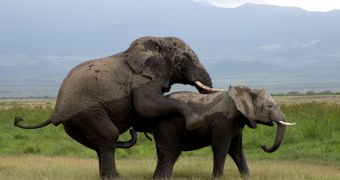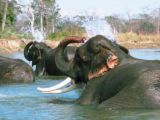1.There are 170 known fossil elephant species that inhabited the whole Earth, except for Australia and Antarctica. The elephants' ancestors appeared 50 million years ago in North Africa, were pig sized and resembled a tapir. Elephants' living closest relatives are sea cows, like manatees, dugongs and hyraxes.
During the Ice Age there were more 6-7 elephant species, including mastodons in North America and mammoths in Eurasia and North America.
Today there are 3 species: the large 4 m (13 ft) tall savanna elephant and the smaller 3 m (10 ft) tall rainforest elephant and the Asian elephant, a forest animal 3 m (10 ft) tall.
In the savanna African elephant the weight difference between male and female can be of two tons, as males weigh on average 6 tons (up to 7.5 tons, the record is 10.5 tons) and females 4. This is the largest living land mammal. The Asian elephant weighs 5 tons in the case of the males and 3 for females.
Elephants are now endangered. In Kenya, in just 10 years the population plummeted from 150,000 to 30,000 and in Zimbabwe from 80,000 to 60,000 (in the same country black rhino population dropped from 3,000 to 300). Even if in many African countries rangers are free to kill poachers, these can be often better armed. Today there are about 600,000 African elephants and 30,000 wild Asian elephants.
2.An elephant herd can have 5-1,000 individuals and it is led by an old female, called matriarch. A herd can contain females and their calves. Young males are driven away from the family when mature, forming separate bachelor herds while mature bulls circulate freely from one clan to another in search for routing cows. The ties are so close amongst the member of a herd that elephants are known to mourn for their dead.
The female gives birth every 4 years. The gestation lasts for 22 months. In 1 % of the cases twins will be born. The newborn calf is 33 in (83 cm) tall and weighs about 250 pounds (112 kg). The calf is suckled for at least two years. A cow usually has 2-4 calves with her, of various ages. Cows defend their young vigorously, charging any intruder. Sexual maturity is achieved at 14-15 years. Elephants can live up to 70 years.
3.An elephant eats daily during the dry season 150-170 kg of food and drinks 80 liters of water, while during the rainy season they eat 200-280 kg of food daily.
Elephants ingest regularly soil containing iron and bicarbonate. Savanna elephants eat mainly grass and woody vegetation (especially during the dry season) while forest elephants eat mainly fruit and woody plants. Elephants digest cellulose with the help of protozoa in the cecum and the thick gut. In Kenya, conservationists even made paper from elephant dung.
They cannot survive more than 24 hours without drinking. That's why elephants are never too far from a water source. Water is also essential for bathing each evening. Elephants are good swimmers and will immerse themselves completely when they find water deep enough. By covering themselves with dirt, elephants protect themselves against insect bites.
If water is scarce during the dry season, elephants dig for water in the sandy bed of a river that has stopped flowing.
Elephant have only 4 functional teeth, 12 in (30 cm) long, which can be replaced 6 times. After the last replacement, the elephant can no longer feed properly.
4.The tusks are not canines, but incisor teeth. In the Asian elephants, only males (and not all) are tusked, while in the African elephant the female carries smaller tusks. The record was a 10 ft (3.3 m) long tusk, which weighed 230 pounds (104 kg) but the average is 2.5 m (83 ft) long and 60 kg (130 pound). In the case of the females, tusks do not weigh more than 18 kg (40 pounds), the average being 7 kg (16 pounds). The tusks of the Asian elephant male are not longer than 2.1 m (7 ft). In extinct mastodons and mammoths, the tusks could be 5 m (17 ft) long!
Because the elephant foot has underside soft cushions, elephants can walk almost noiselessly. A walking elephant has a speed of about 5.5 mi (9 km) per hour and it "runs" with a speed of 25 mi (40 km) per hour, faster than the most rapid human athletes, despite their huge size. Elephants living in the forest are sedentary, but those in dry places migrate, traveling up to 500 km (300 mi).
5.Besides the trumpeting (expressing anger) and throaty rumbling similar to gargling which we hear, elephants also communicate through infrasounds with a frequency of 14-24 Hz. The advantage of the infrasounds is that they can cross vast distances, without being attenuated by the vegetation. This explains why elephant herds located at great distances one from another move in a coordinated way. The infrasounds are produced by a membrane located in the forehead, where the trunk unites to the skull.
Each elephant has a specific vocal timbre. The calls of the elephants have various meanings, from aggression to alarm call when searching for lost offspring. When spotting a possible danger, elephants stop rumbling.
They express aggression by threatening with twirled trunk and by throwing dust in the air. The African elephant also flutters its enormous ears.
6.Like children, elephants must be disciplined by the members of their collectivity to turn into responsible members of the elephant society. But male elephants that were orphans turned into adult delinquents in a reserve in South Africa, as they had never been kept under control by mature elephants.
The balky elephants attacked people (killing two, including a professional hunter), killed 19 white rhinos in three years and even attempted mating with rhinoceroses. When adult bulls from a group were moved amongst delinquents, they restored order and a more proper behavior in young bulls.
7.Elephants of Digboi (northeastern India) are fascinated by oil. They roam through the oil fields when important valves from the pipes connecting the wells to the refinery are open. They seem to enjoy the sound made by valves when opening, especially those controlling the vapors which impede the oil turning into paraffin. But it's not all about the gushing oil, but also the mud and the water getting out with the oil. The water is salty and this is what elephants want.
In fact, an elephant led to the discovery of this oil field during the British occupation. A British official working at the first railway in the area noticed an oily substance on the limb of an elephant. Following the traces of the elephant, he discovered a bubbling oil pool. That was the first oil field opened in Asia, in 1889.
8.What's the weight of a cloud? 550 tons of water. About 100 elephants! All in minute droplets floating on ascending hot air. This is a normal cumulus cloud.
But a storm cloud can have the weight of 200,000 elephants. A hurricane cloud means 40 million elephants, more than the existing elephants on the planet.
9.A trunk can sniff at a long distance from the owner's face, grab things, or march across a pool underwater, using it as a snorkel. Because the trunk does not have bones, it's extremely mobile. In fact, nose bones are greatly reduced and not only in elephants, but also in other mammals that developed rudimentary trunks (like tapirs).
A trunk contains more than 40,000 muscles and tendons and its tip is very sensitive, making it very precise (elephants can pick up from the floor objects which are the size of a coin).
In addition, there is one (in African elephant) or two (in Asian elephant) "fingers" on the tip to grasp small objects. This prehensile "hand" can weigh 400 lb. (160 kg) and measure 7 feet (2,1 m), being able to lift objects of more than 300 lb. (120 kg). A man can be thrown 35 m (116 ft) away with the trunk and 2 tons can be dragged by trunk.
The elephant can collect gallons of water with the trunk and then give itself a quick shower; or reach the highest, freshest leaves off a tree.
It may be used to chase away flies or to hug affectionately another elephant's trunk. Changes in nostril size shift the sound of the elephant calls. Elephants also wade into pools and use the tip of their trunk as a snorkel as it swims to the other side, breathing easily.
Humans can only use a foot long snorkel tubes, because for deeper snorkels the mismatch between air pressure inside lungs and the increasing outside pressure can make blood vessels swell.
But elephant lungs are different: instead of having a pleural space between lungs and the chest case as humans and most mammals do, elephants have dense sheets of fibery tissue, allowing their lungs to withstand pressures that would cause human lungs to collapse. This is a sign that elephant ancestors were aquatic creatures. Indeed, their closet living relatives seem to be the sea cows, like manatees and dugongs.
10.Have you ever wondered why elephants have a wrinkled skin? The folding of their skin helps them regulate their temperature and keep its humidity. The wrinkled skin retains 5-10 times more water than a smooth skin and the mud stuck on it dries much harder, keeping coolness for longer periods. The wrinkled skin also loses more heat, cooling down the animal.

 14 DAY TRIAL //
14 DAY TRIAL // 

